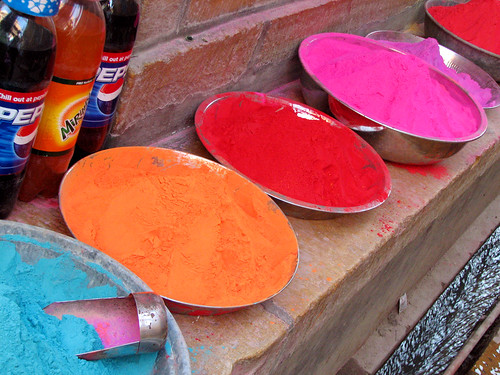One of the major festivals of India, Holi is celebrated with enthusiasm and gaiety on the full moon day in the month of Phalgun which is the month of March as per the Gregorian calendar.
Lovers too long to apply colours on their beloved. This has a popular legend behind it. It is said that the naughty and mischievous Lord Krishna started the trend of playing colours. He applied colour on her beloved Radha to make her one like him. The trend soon gained popularity amongst the masses. No wonder, there is no match to the Holi of Mathura, Vrindavan and Barsana - the places associated with the birth and childhood of Radha and Krishna
History and Meaning of Holi
Holi Celebrated all over India since ancient times, Holi's precise forpurpose display great variety. Originally, Holi was an agricultural festival celebrating the arrival of spring.
This aspect still plays a significant part in the festival in the form of the colored powders: Holi is a time when man and nature alike throw off the gloom of winter and rejoice in the colors and liveliness of spring.
Holi also commemorates various events in Hindu mythology, but for most Hindus it provides a temporary opportunity for Hindus to disregard social norms, indulge in merrymaking and generally "let loose."
The legend commemorated by the festival of Holi involves an evil king named Hiranyakashipu. He forbade his son Prahlad from worshipping Vishnu, but Radhu continued to do offer prayers to the god. Getting angry with his son, Hiranyakashipu challenged Prahlad to sit on a pyre with his wicked aunt Holika who was believed to be immune to fire. (In an alternate version, Holika put herself and Prahlad on the fire on orders from her brother.)
Prahlad accepted the challenge and prayed to Vishnu to keep him safe. When the fire started, everyone watched in amazement as Holika was burnt to death, while Prahlad survived without a scar to show for it. The burning of Holika is celebrated as Holi. According to some accounts, Holika begged Pram and hlad for forgiveness before her demise, and he decreed that she would be remembered every year at Holi.

Traditional Holi
The spring season, during which the weather changes, is believed to cause viral fever and cold. The playful throwing of natural coloured powders has a medicinal significance: the colours are traditionally made of Neem, Kumkum, Haldi, Bilva, and other medicinal herbs prescribed by Āyurvedic doctors.
A special drink called thandai is prepared (commonly made of almonds, pistachios, rose petals, etc.), sometimes containing bhang (Cannabis indica). For wet colours, traditional flowers of Palash are boiled and soaked in water over night to produced yellow coloured water, which also had medicinal properties. Unfortunately the commercial aspect of celebration has led to an increase in the use of synthetic colours which, in some cases, may be toxic.
my son in holi colours

Holi in tampa



No comments:
Post a Comment